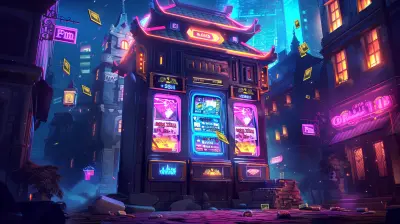The Hidden Costs of 'Free' Mobile Games
14 October 2025
In a world where mobile games are just a tap away and labeled with that oh-so-tempting word — “FREE” — it’s easy to get drawn in. After all, who doesn’t love free stuff? But here’s the kicker: many of these mobile games that tout themselves as “free” come with a laundry list of hidden costs that you might not notice until you've already fallen deep into the rabbit hole.
Let’s peel back the curtain and take a deeper look at what you’re actually signing up for when you hit that download button.
What Do We Mean by "Free"?
Let’s be honest. Nothing in life is truly free — and mobile games are no exception. The label “free-to-play” (F2P) is incredibly misleading. Sure, you don’t pay a cent to install the game, but once you're in, it's a whole different ball game.You’re entering a world designed to subtly nudge you toward spending money, handing over your data, and giving up your time — often in ways you don’t even realize.
Free? Not exactly.
1. The Microtransaction Trap
Ever heard of “just one more level”? That’s the siren song of mobile games. You start off strong, flying through early levels, then suddenly — BAM — you hit a wall. Now the game’s offering you power-ups, extra lives, or exclusive items... for just $0.99. Seems harmless, right?But these microtransactions add up. Studies have shown that some players spend hundreds or even thousands of dollars on free mobile games. It’s like death by a thousand cuts — each purchase seems small, but over time, your wallet feels the sting.
A Domino Effect of Spending
- $0.99 today for extra lives
- $4.99 tomorrow for a special weapon
- $19.99 next week for a "limited-time offer"
Before you know it, you've spent more than the cost of a full AAA console game — and you don’t even own the content outright.
2. Pay-to-Win Pressure
Let’s keep it real — nobody likes losing. And some of these games know exactly how to play on that.In a competitive environment, especially PvP (player versus player) games, paying players get an unfair edge. They climb leaderboards faster, unlock better gear, and crush the competition.
If you're playing for free, it’s like bringing a spoon to a sword fight. Suddenly, you’re tempted to pay just to even the playing field. And that’s exactly what the developers want.
It’s not fun anymore when skill takes a backseat to payment. It’s like trying to win a race where everyone else paid for nitro boosts while you’re running barefoot.
3. The Time Sink Strategy
Time is money. And mobile games are absolute geniuses at wasting yours.They use wait timers, energy systems, or build queues that force you to either:
- Wait hours (sometimes days) to progress
- Or pay to skip the wait
This is no accident. It's a psychological tactic known as "soft gating," designed to frustrate you just enough so you’ll feel like spending real money to keep playing.
Here’s an example:
> "Build will complete in 6 hours... or speed up now for 500 gems!"
And of course, you don’t have 500 gems. So guess what? Time to visit the in-game store.
4. Data Harvesting – The Invisible Tax
If you’re not paying with cash, chances are you’re paying with your data.Free games often ask for a scary level of access: your contacts, location, even microphone usage. And while some of this may seem necessary for gameplay, much of it is used to build a profile on you — one that’s then sold to advertisers.
This data powers the ads you see not just in-game, but across your entire online experience. So while you’re flinging birds at pigs, the game is busy logging:
- How long you play
- What you click
- What times you're active
You become the product.
5. Ad Overload and Distractions
Let’s talk about ads. Some mobile games are downright unplayable because of how riddled they are with ad interruptions.You finish a level — ad.
You want a bonus — ad.
You pause the game — ad.
It’s relentless. And often, the “X” button to close the ad is hidden, delayed, or barely visible, tricking you into clicking and driving up their ad revenue.
These ads aren't just annoying — they interrupt your flow, break immersion, and sometimes even push dodgy content. All that “free” fun comes at the cost of your mental bandwidth.
6. Subscription Models Sneak In
Here's something that’s becoming more common: "VIP" subscriptions.They sound great at first — no ads, daily bonuses, extra content — for just $4.99 a week. But guess what? That’s $20 a month. For a MOBILE GAME.
And the worst part? Many of these subscriptions renew automatically. Miss the fine print, and you could be paying for months before you notice.
It’s like signing up for a gym membership you never use — but for pixels.
7. Emotional Manipulation Through Game Design
Ever wondered why some games keep pulling you back, even when you're not having fun anymore? Behavioral psychologists work hand-in-hand with game developers to craft experiences that leverage your instincts.Things like:
- Variable rewards (like slot machines)
- FOMO through limited-time events
- Guilt-tripping with cute in-game characters (“Don’t leave me!”)
You’re not just playing a game. You’re the mouse in a lab experiment — and the cheese is your wallet.
8. The Toll on Mental Health
Let’s face it. When a game becomes more about grinding, spending, or chasing rank than having fun, it’s no longer relaxing — it’s stressful.That constant push to log in daily or fall behind can trigger:
- Anxiety
- Frustration
- Sleep disruption
- Performance pressure
Gaming should be a hobby — not a second job.
And when that pressure gets tied to money, it’s a recipe for regret and burnout.
9. Kids Are Especially Vulnerable
Now imagine all of this — but targeted at kids.Children often don’t understand real-world currency or the consequences of in-app purchases. Bright colors, flashy animations, and persuasive text are all designed to make them click that “Buy Now” button without a second thought.
There have been countless horror stories of kids racking up hundreds — sometimes thousands — of dollars on their parents’ accounts. And while some platforms now include parental controls, enforcement is still spotty.
10. Ownership? Nope — You're Renting Entertainment
Here’s the truth bomb: You don't own anything in these free mobile games.That epic sword you paid $9.99 for? It’s just a line of code on someone else’s server. If the game shuts down tomorrow — it’s gone.
Mobile games can vanish overnight due to low profitability, licensing issues, or developer burnout. And your progress, purchases, and memories disappear with them. Poof.
You never really bought anything. You just leased it, until someone else pulls the plug.
The Smarter Way to Game
Okay, so are all mobile games bad? Not at all.Some are brilliant and respectful of your time and money. But it’s crucial to be conscious of how these “free” games are monetized. Ask yourself:
- Is this game enriching my life or draining it?
- Am I spending more than I intended?
- Is this still fun, or am I just stuck in a loop?
You deserve to play on your terms — not just how the developers want you to.
How to Protect Yourself
Let’s wrap this up with a few practical tips to keep your gaming healthy and budget-friendly:🔒 Set In-App Purchase Limits
Use your device’s parental or screen time settings to prevent impulse spending.⏰ Watch Your Time
Set timers or reminders so you don't lose hours to endless grinding or ads.💳 Avoid Linking Credit Cards
Consider using gift cards or pre-paid digital wallets when needed. It adds friction before spending.🧠 Be Emotionally Aware
Don’t let frustration or fear of missing out push you into purchases. Take breaks and step back if needed.Final Thoughts
Free mobile games aren't evil. But they are designed to make money — and the more you’re aware of how they do it, the better equipped you are to enjoy them without falling into the trap.So next time you go to download a “free” game, remember: the download costs nothing, but you better know what you’re actually signing up for.
Don’t let your time, money, and peace of mind become collateral damage in the name of pixelated fun.
Play smart. Play safe. Play free — for real this time.
all images in this post were generated using AI tools
Category:
In Game PurchasesAuthor:

Lana Johnson
Discussion
rate this article
1 comments
Zeal Thomas
Great insights! It's easy to overlook the hidden expenses in free mobile games. This article sheds light on an important topic that many players ignore. Thank you!
October 20, 2025 at 4:03 AM

Lana Johnson
Thank you for your feedback! I'm glad you found the article helpful in highlighting these often-overlooked costs.


